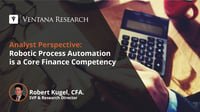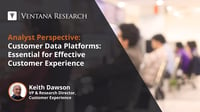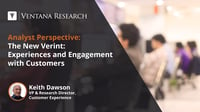The pandemic accelerated several trends in the contact-center industry that were already underway, chiefly: moving infrastructure and software applications to the cloud, and rethinking the process of managing agents. One byproduct of these trends is a renewed look at the similarities between business-phone systems (also known as unified communications, or UC) and contact center systems (CC).
Read More
Topics:
Customer Experience,
Analytics,
Collaboration,
Contact Center,
agent management,
AI & Machine Learning
Robotic Process Automation (RPA) has emerged as a core digital technology for finance and accounting organizations. It can drive significant gains in productivity and efficiency by automating mechanical, repetitive accounting processes in a continuous, end-to-end fashion. RPA improves efficiency, ensures data integrity and enhances visibility into processes.
Read More
Topics:
Office of Finance,
Business Planning,
Financial Performance Management,
Price and Revenue Management,
ERP and Continuous Accounting,
robotic finance,
Predictive Planning
The modern contact center relies heavily on software that enables agents to perform multiple complex tasks while simultaneously managing the customer-facing side of interactions. This has allowed CRM vendors to build tools, such as agent desktop interfaces, that control virtually all aspects of the service environment.
Read More
Topics:
Sales,
Customer Experience,
Voice of the Customer,
Contact Center,
Sales Performance Management,
Workforce Management,
agent management,
sales enablement
The ways in which consumers engage with organizations have changed. Long-established communication channels such as the telephone, email and company websites are still used, but many consumers now prefer to use text messages, online chat, social media, virtual agents and applications on their mobile devices to contact the company and address issues. As a result, organizations have had to add support for many new channels of customer engagement.
Read More
Topics:
Customer Experience,
Contact Center,
agent management
Shifts in the market due to the pandemic have upended the contact center marketplace, accelerating the inevitable migration of infrastructure to the cloud and changing the way agents are managed. The pandemic also increased the dependence customers have on contact centers in the absence of in-store buying.
Read More
Topics:
Customer Experience,
Voice of the Customer,
Contact Center,
agent management
There is no doubt that the pandemic has accelerated the existing need for new technology that can help sales professionals do their jobs well in this quickly evolving market. In addition, market trends are driving the need for functionality that is aimed at the front-line sales professional and the manager, highlighting the demand for tools that can help arrest the decline in quota attainment, as well as helping salespeople supplement their traditional focus on sales quotas with activities such...
Read More
Topics:
Sales,
embedded analytics,
Analytics,
Internet of Things,
Sales Performance Management,
natural language processing,
sales enablement,
AI & Machine Learning
Organizations are increasingly using data as a strategic asset, which makes data services critical. Huge volumes of data need to be stored, managed, discovered and analyzed. Cloud computing and storage approaches provide enterprises with various capabilities to store and process their data in third-party data centers. The advent of data platforms previously discussed here are essential for organizations to effectively manage their data assets.
Read More
Topics:
embedded analytics,
Analytics,
Business Intelligence,
Collaboration,
Data Governance,
Data Lake,
Data Preparation,
Data,
AI & Machine Learning,
Microsoft Azure
Since customer data platforms (CDP) emerged in the marketplace about five years ago, there has been debate about what roles they fill, especially within customer service organizations. They were originally developed by small software firms to provide marketing teams with a comprehensive view of customer records. Those records could be scattered throughout an organization, siloed by system and department. CDPs were an attempt to shortcut integration processes that are long, expensive and often...
Read More
Topics:
Customer Experience,
Marketing,
data artisan,
Data Governance,
Data Lake,
Data Preparation,
Data,
Information Management (IM),
intelligent marketing
With modern enterprises adopting and expanding their digital business with subscription and usage business, organizations need to think beyond the primacy of sales as their source of business success. A sustained customer experience is key, representing an organizational and cultural shift from the traditional emphasis on new sales to an equally important focus on customer retention and upsell/cross-sell opportunities. This mindset is also important to organizations involved in digital commerce...
Read More
Topics:
Sales,
Marketing,
Analytics,
Product Information Management,
Sales Performance Management,
Financial Performance Management,
Price and Revenue Management,
Digital Commerce,
Subscription Management
Verint has recently separated into two companies, one of which is a dedicated provider of software focused on customer engagement and will keep the Verint name. (The other is called Cognyte and focused on security analytics.)
Read More
Topics:
Customer Experience,
Voice of the Customer,
Analytics,
Contact Center,
agent management
Simply defined, an “HR-M&A lifecycle” is the sequence of critical workforce and HR-related activities and decisions that span due diligence through business integration after an M&A event is announced. Until recently, these potentially game-changing events were not the province or focus of HR technology offerings. This is due in part to HCM systems that, historically, were designed primarily to automate and optimize typical HR/HCM processes and events that occur throughout the year, to better...
Read More
Topics:
Human Capital Management,
Workforce Management,
Total Compensation Management,
employee experience
Even the most casual observer of HR Technology trends and associated vendor marketing themes will have noticed that the notion of “putting people first” has become ubiquitous as a way for vendors to distinguish themselves. This has become a double-edged sword. Customers ultimately benefit from the intense competition to add functionality that supports this claim, resulting in richer and more robust offerings. The downside, as is the case when any core plank in vendor value propositions becomes...
Read More
Topics:
Human Capital Management,
Workforce Management,
Total Compensation Management,
employee experience
The contact center is still, for most businesses, where customer experience is designed, delivered and measured. And as we might expect, customer experience (CX) tools are migrating from where they started point solutions based on narrow functions into broader suites that encompass multi-departmental functions and reach across customer journeys. The goal is to provide more consistency across interactions, and to provide organizations with deeper insights into customer behavior along with...
Read More
Topics:
Customer Experience,
Marketing,
Voice of the Customer,
Contact Center,
Digital Commerce,
Enterprise Resource Planning,
agent management
The current pandemic has disrupted many of the traditional sales methods used by field-sales organizations to engage, and sell to, buyers. In an effort to provide help, many vendors have recently announced new features that focus less on the management of sales organizations and more on tools to help salespeople sell. This has been coupled with a renewed interest in using data to help with the science, alongside the art, of selling, as referenced in my AP: The Art and Science of Sales from the...
Read More
Topics:
Sales,
Analytics,
Data,
Product Information Management,
Sales Performance Management (SPM),
Digital Technology,
sales enablement,
Sales Engagement,
AI & Machine Learning






















